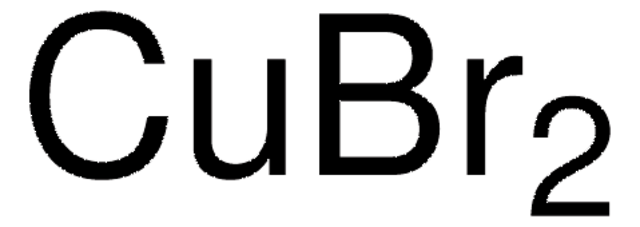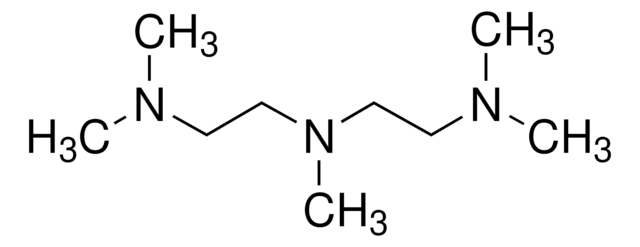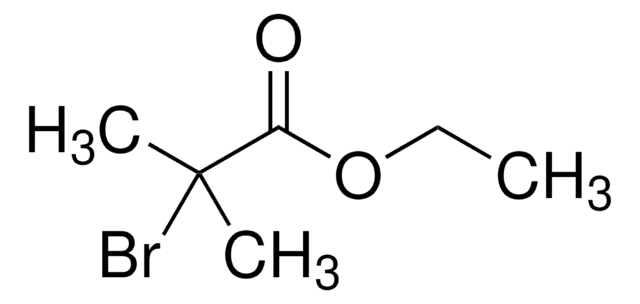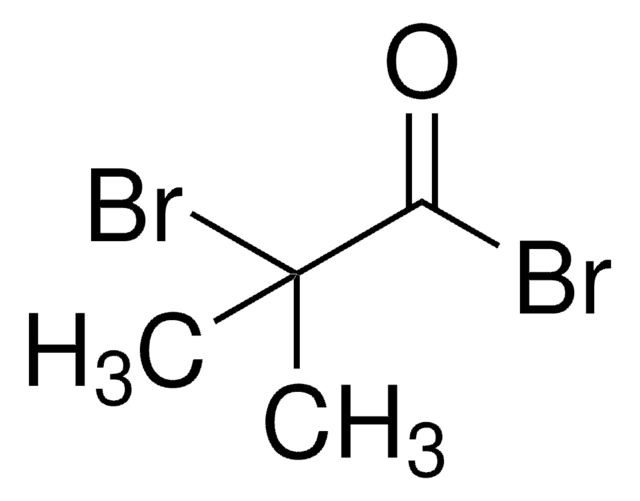254185
Kupfer(I)-bromid
99.999% trace metals basis
Synonym(e):
Cuprous bromide
About This Item
Empfohlene Produkte
Qualitätsniveau
Assay
99.999% trace metals basis
Form
powder
Eignung der Reaktion
reagent type: catalyst
core: copper
Verunreinigungen
≤15.0 ppm Trace Metal Analysis
mp (Schmelzpunkt)
504 °C (lit.)
Dichte
4.71 g/mL at 25 °C (lit.)
Anwendung(en)
battery manufacturing
SMILES String
[Cu]Br
InChI
1S/BrH.Cu/h1H;/q;+1/p-1
InChIKey
NKNDPYCGAZPOFS-UHFFFAOYSA-M
Suchen Sie nach ähnlichen Produkten? Aufrufen Leitfaden zum Produktvergleich
Allgemeine Beschreibung
Anwendung
- Als lösungsverarbeitende Lochtransportschicht (HTL) für organische Solarzellen (OSCs). CuBr verbessert die Leistungsumwandlungseffizienz von Solarzellen.
- Als Vorstufe zur Synthese von photolumineszierenden metallorganischen Gerüsten (MOFs).
- Zur Synthese von hoch emissiven dreikoordinierten Kupfer(I)-Komplexen als Dotierstoff in OLEDs mit einem maximalen externen Quantenwirkungsgrad von 21,3 %.
- Als ein Katalysator mit Liganden für Atom-Transfer-Radical-Polymerisation (ATRP) Reaktion von tertiären Alkylhalogeniden in 14 verschiedenen Lösungsmitteln zur Bestimmung der Ratenkonstante.
- Zur Synthese des makrozyklischen Polymers über intramolekulare Radikalfänger-gestützte Atom-Transfer-Radical-Kupplung.
Signalwort
Danger
Gefahreneinstufungen
Acute Tox. 4 Dermal - Acute Tox. 4 Oral - Aquatic Acute 1 - Aquatic Chronic 1 - Eye Dam. 1 - Skin Irrit. 2
Lagerklassenschlüssel
11 - Combustible Solids
WGK
WGK 3
Flammpunkt (°F)
Not applicable
Flammpunkt (°C)
Not applicable
Persönliche Schutzausrüstung
Eyeshields, Gloves, type N95 (US)
Analysenzertifikate (COA)
Suchen Sie nach Analysenzertifikate (COA), indem Sie die Lot-/Chargennummer des Produkts eingeben. Lot- und Chargennummern sind auf dem Produktetikett hinter den Wörtern ‘Lot’ oder ‘Batch’ (Lot oder Charge) zu finden.
Besitzen Sie dieses Produkt bereits?
In der Dokumentenbibliothek finden Sie die Dokumentation zu den Produkten, die Sie kürzlich erworben haben.
Kunden haben sich ebenfalls angesehen
Artikel
We carry a large variety of electrophiles and nucleophiles that are widely used in C–C bond-forming reactions. This group of products contains many organometallic reagents as well as commonly-used alkylating and acylating reagents.
We presents an article about a micro review of reversible addition/fragmentation chain transfer (RAFT) polymerization. RAFT (Reversible Addition/Fragmentation Chain Transfer) polymerization is a reversible deactivation radical polymerization (RDRP) and one of the more versatile methods for providing living characteristics to radical polymerization.
We presents an article about Copper(I)-mediated Living Radical Polymerization in the Presence of Pyridylmethanimine Ligands, and the emergence of living radical polymerization mediated by transition metal catalysts in 1995, which was a seminal piece of work in the field of synthetic polymer chemistry.
Applying ARGET ATRP to the Growth of Polymer Brush Thin Films by Surface-initiated Polymerization
Protokolle
We present an article about RAFT, or Reversible Addition/Fragmentation Chain Transfer, which is a form of living radical polymerization.
We presents an article featuring procedures that describe polymerization of methyl methacrylate and vinyl acetate homopolymers and a block copolymer as performed by researchers at CSIRO.
An article about the typical procedures for polymerizing via ATRP, which demonstrates that in the following two procedures describe two ATRP polymerization reactions as performed by Prof. Dave Hadddleton′s research group at the University of Warwick.
Unser Team von Wissenschaftlern verfügt über Erfahrung in allen Forschungsbereichen einschließlich Life Science, Materialwissenschaften, chemischer Synthese, Chromatographie, Analytik und vielen mehr..
Setzen Sie sich mit dem technischen Dienst in Verbindung.

![Tris[(1-Benzyl-1H-1,2,3-Triazol-4-yl)methyl]amin 97%](/deepweb/assets/sigmaaldrich/product/structures/179/695/86a721c8-2a4c-4e4f-bc36-6276ce7a941f/640/86a721c8-2a4c-4e4f-bc36-6276ce7a941f.png)







![Tris[2-(dimethylamino)ethyl]amin 97%](/deepweb/assets/sigmaaldrich/product/structures/695/792/ee0ff167-22a3-43a7-83a1-6c4908adf0ae/640/ee0ff167-22a3-43a7-83a1-6c4908adf0ae.png)
